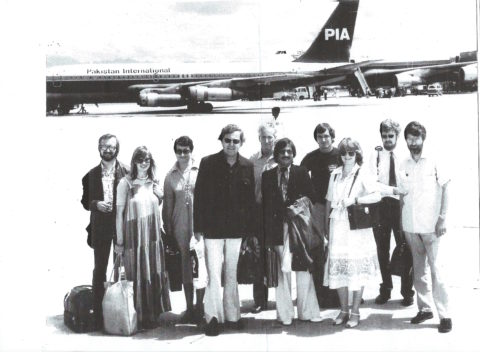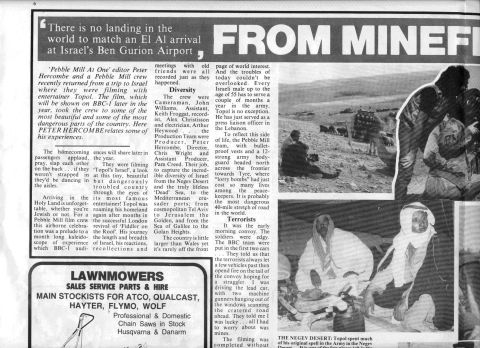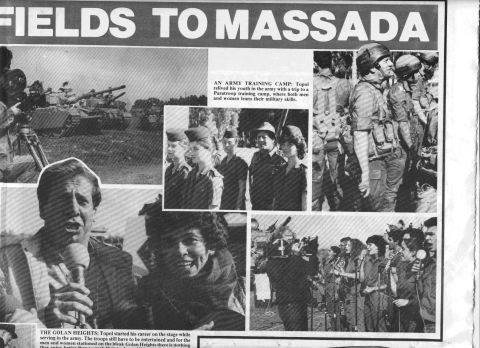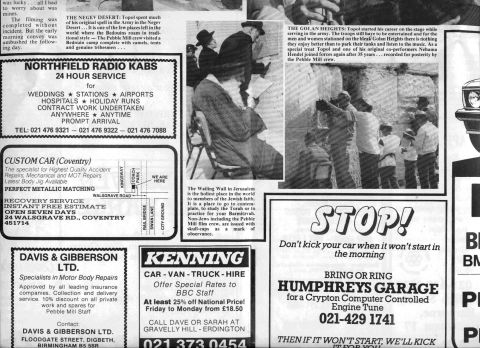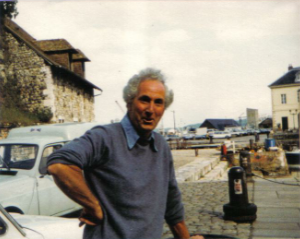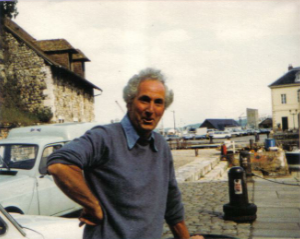
Arthur Heywood
Yesterday’s funeral.
Annie asked me if I would say a few words today because Arthur loved his life as a member of a crew with the BBC Film Unit in Birmingham. As a lighting cameraman, I was part of that Unit, and I worked with Arthur on many occasions filming, often 0n the other side of the world. Most productions, apart from drama, a crew would be made up of four people. Two on camera, one sound, one lights. Arthur would be in charge of lights and he was there not only to light the set but to make sure people like me did not get the chance to electrocute anyone, which of course the BBC knew I would, if given the opportunity
Crews were close knit units, often away for weeks, very much dependent on each other, not only for the success of a production, but sometimes even their lives.
We lived together, worked together, and played together.
You just had to get on , but it meant we had very few secrets we could keep from one another.
No No No. It’s ok Arthur I won’t go on!
So when Annie asked me to say a few words of course I said yes!
But where do I start about Arthur, there are so many stories to tell?
In the end it was Annie who gave me the clue. When I heard Arthur had died I sent Annie my condolences and she replied, as only she can, that she thought Arthur was already at the bar with a pint and G&T.
So I think that is a good a place to start as any!
Knowing Arthur as I do, Annie is probably right, but not before he had checked that the bar itself had been made out of a beautiful turned peace of solid oak or teak and not the horrible plasticky stuff you get these days. That the gin was Gordon’s and not Haighs. and that the beer was real and didn’t come out of aluminium barrels. He would have that twinkle in his eye he always kept for special occasions, it would have been used to his advantage in seeing who was behind the bar.
There are so many stories I could tell but let me just pick two that stay in the memory. The first is about one’s past and how it has a habit of catching up with you no matter where you are or how long ago.
Most evenings when filming had finished we would meet up in one or other of our rooms and have a drink together. It would be a time to relax, talk over the day decide where to eat etc. and perhaps let your guard down.
One such time in the eighties I found myself with Arthur in Israel shooting a documentary on the famous Topol, of ‘Fiddler On the Roof’ fame. I’d never been to Israel before, but I knew Arthur had. He had mentioned to me he had been here before back in 1947 when it was then Palestine and he was in the army as part of the British forces trying to keep the peace between Jews and Arabs.
One evening when we were in Tel Aviv, and after several G&Ts we got Arthur talking about this time. He spoke of the difficulties they had to face, of being caught up in the conflict not knowing who to trust, Arab or Jew. By accident he let slip he’d met a lady who had been a singer and could even remember her name and that she lived here in this town.
Of course we were on him in a flash! Do you think she is still around? What name did you say? Out of nowhere a telephone book was produced together with the number of someone with the same name and initials.
Go on Arthur Phone! Reluctantly, but never one to refuse a challenge, especially with all of us egging him on he phoned and naturally, we all tried to listen in. To everyone’s amazement, even after nearly 40 years, the voice on the end recognized him immediately.
He made a rendezvous and tried to keep it secret but in reality there was not much hope of that! We felt we had to spy on him just to see if the lady would past muster which she did, and that Arthur was safe, which he was, only then could we allow him some privacy.
Please Don’t ask me what was going on with the production at this time cos I’ve forgotten, but there is a lovely sequel to this story and Annie has filled me in with some of the details.
The lady’s name was Lucie. Young and in love she was the first girl Arthur ever proposed to, but evidently the differences in backgrounds and religion meant that consent was not forthcoming from her father. Surprise that!! Not long after Arthur and his unit left Palestine for Cyprus.
A year or so after our meeting in Israel, Arthur, in his usual way, invited Lucia and her family over to stay putting panic in the Haywood house hold. What do you feed a Jewish couple on? Did they drink alcohol? We would have to have a new cookbook and new saucepans!!
They need not have worried. They arrived and nearly died laughing, they weren’t orthodox so apart from missing out on Sunday morning bacon sandwiches nothing was a problem. And as Annie says, Every cloud has a silver lining, she got new saucepans and a cookery book!
The next story I want to tell happened very early on in my career and the first one I was asked to shoot abroad. I was determined to impress.
It was about the then Bishop of Birmingham, who had been Bishop of Singapore when the Island was over run by the Japanese during the second world war and of a Japanese Officer who as a Christian helped save the Bishop’s life and in return, at the end of the conflict the Bishop was able to save his. The film would start with them meeting each other for the first since the war ended and we would be shooting it in Singapore.
We flew out in a Britannia, courtesy of the RAF, stopping off at Gann to refuel. This was a RAF staging post set on a small island in the middle of the Indian Ocean, and more to the point, it was duty freeI! This meant we could pick up a generous supply of booze, all at ridiculously low prices.
We arrived at out hotel in the early hours of the morning with everyone wide awake thanks to jet lag and no one wanting to go to bed. The sky was beautifully star lit and it was lovely and warm. So much we decided to all meet up on the patio by the director’s room that was right by the side of the pool and have a night cap. Once we had settled in I needed to talk to production so went ahead giving my assistant, what I thought was a simple job. The responsibility of carrying the night’s refreshment to the pool.. I still don’t know how it happened but, moments later there was an enormous scream, I found my assistant had managed to throw himself into the 4 foot deep storm ditch that surrounded the hotel seriously twisting his ankle and was obviously in great pain.
What made matters considerably worse he had smashed all the booze!
We were in deep trouble, no not the booze this time.
In only a few hours we would have to start shooting as our two main characters were arriving at the airport and there was no way my assistant could walk let alone help with the camera.
It would have been extremely difficult for me to carry on without an assistant. For one thing it would slow us down and we would lose time, time we did not have.
It was Arthur who saved the day. He immediately volunteered to step in and do what he could.
The transition between lighting and camera would not be easy. Both jobs are completely different each requiring specialized skills. Fortunately for me I knew Arthur had always been interested in what was going on around the camera even to the extent of coming out on occasion as a second assistant. Then it didn’t matter so much, now it did! I can only say he did it brilliantly. The crucial meeting we had to get right was successfully filmed that morning and most of the story had been shot by the time my assistant was back on his feet. He appeared very sheepishly three days later having spent most of the time lying by the side of the pool.
I’m sure Arthur enjoyed those few days actually on the camera but I’m pretty sure too, it was with some relief when he returned to what he called his proper job.
Arthur was one of those guys who could put his hands to almost anything and often did. Lucky were the ones who were able, allowed, to take a look inside Arthur’s workshop at home. Here you would find a treasure trove of tools of every description all neatly stored plus a wood turning lathe. He would spend hours there, with Annie’s permission of course. How cruel it must have been for him when he found he could no longer do the things he loved.
Before I close I must say a word about Annie,
and how important it was for us, living in the mad world that often surrounded a film crew, to have some one at home who could cope. I cannot remember when or where he found her or even if she found him but I do know he struck gold and he never looked back. And it has showed over the years with the love they shared for one another.
His job entailed trust on both sides;
the gorgeous ladies he worked with when filming were real friends to him, and to Annie. They would take her under their wing whenever she turned up on location as did all the crew.
Arthur was not the easiest of persons at times so I know she would have had her work cut out on a bad day. Especially I think of how that love and caring has been put to the test over these last few difficult years.
Annie admits to being being wife number 3 (and a half because he lived for some years with a lady in Suffolk, someone she is still in touch with) and she was used to hearing about his exploits with ex girl friends and wives.
Annie has stayed in contact with many of these friends and also with Eileen, Arthur’s first wife, who is here today with Arthur’s son Peter.
I found Arthur an utterly dependable trustworthy colleague and the sort of man you would want to have by your side at any sign of trouble.
I and many others have lost a good friend but Arthur lived a full and active long life, some of which I was privileged to share. There will be sadness of course but he would not want people to be miserable.
Yes, I do see Arthur ensconced at the bar with a Beer or G&T in hand , and that twinkle in his eye.
I know he would want us all to drink to that!
John Williams
